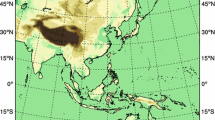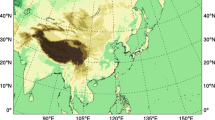Abstract
Tropical cyclones (TCs) simulated at gray-zone resolution (9 km) in the Advanced Research version of the Weather Research and Forecasting Model (WRF-ARW) are evaluated over the Western North Pacific (WNP) during 11-year (2008–2018) TC seasons (June–November). The effects of the cumulus parameterization (CPS) are tested with two sets of numerical experiments: one involving CPS (ICPS) and one without (NICPS). Through comparisons with the observation and reanalysis, it is shown that the ICPS experiment yields good skills in simulating TC frequency due to more realistic large-scale mean states, including stronger low-tropospheric circulation, wetter mid-tropospheric environment, and stronger ascending motion over the TC main development region (MDR). On the other hand, the NICPS experiment is found to better reproduce intense TCs (Saffir–Simpson hurricane categories 3, 4 and 5) in terms of intensity, accumulated cyclone energy (ACE), and inner-core size. NICPS can also reasonably capture TC inner-core structure with stronger radial inflow in the boundary layer, rising motion around the eyewall and outflow in the mid to upper troposphere. Nevertheless, NICPS significantly underestimates TC outer size due to rapidly decay of TC outer wind field, suggesting limited severe convective activities in the outer region.














Similar content being viewed by others
Data availability
The IBTrACs data used in this study can be accessed at https://www.ncei.noaa.gov/products/international-best-track-archive?name=ib-v4-access. The ERA5 reanalysis data could be available from https://cds.climate.copernicus.eu/.
References
Bell G, Chelliah M (2000) The 1999 North Atlantic and eastern North Pacific hurricane season [in “Climate Assessment for 1999”]. Bull Am Meteorol Soc 81:S19–S22
Bian GF, Nie GZ, Qiu X (2021) How well is outer tropical cyclone size represented in the ERA5 reanalysis dataset? Atmos Res 249:105339
Bretherton CS, McCaa JR, Grenier H (2004) A new parameterization for shallow cumulus convection and its application to marine subtropical cloud-topped boundary layers. Part I: description and 1D results. Mon Weather Rev 132:864–882
Camargo SJ (2013) Global and regional aspects of tropical cyclone activity in the CMIP5 models. J Clim 26:9880–9902
Camargo SJ, Wing AA (2016) Tropical cyclones in climate models. Wiley Interdiscip Rev Clim Change 7:211–237
Camargo SJ, Emanuel KA, Sobel AH (2007) Use of a genesis potential index to diagnose ENSO effects on tropical cyclone genesis. J Clim 20:4819–4834
Camargo SJ, Tippett MK, Sobel AH et al (2014) Testing the performance of tropical cyclone genesis indices in future climates using the HiRAM model. J Clim 27:9171–9196
Davis CA (2018) Resolving tropical cyclone intensity in models. Geophys Res Lett 45:2082–2087
Durden SL (2013) Observed tropical cyclone eye thermal anomaly profiles extending above 300 hPa. Mon Weather Rev 141:4256–4268
Emanuel K, Sobel A (2013) Response of tropical sea surface temperature, precipitation, and tropical cyclone-related variables to changes in global and local forcing. J Adv Model Earth Syst 5:447–458
Eyring V, Bony S, Meehl GA et al (2016) Overview of the coupled model intercomparison project phase 6 (CMIP6) experimental design and organization. Geosci Model Dev 9:1937–1958
Fu D, Chang P, Patricola CM et al (2019) High-resolution tropical channel model simulations of tropical cyclone climatology and intraseasonal-to-interannual variability. J Clim 32:7871–7895
Fudeyasu H, Wang Y (2011) Balanced contribution to the intensification of a tropical cyclone simulated in TCM4: outer core spinup process. J Atmos Sci 68:430–449
Gentry MS, Lackmann GM (2010) Sensitivity of simulated tropical cyclone structure and intensity to horizontal resolution. Mon Weather Rev 138:688–704
Han Y, Zhang M, Xu Z et al (2022) Assessing the performance of 33 CMIP6 models in simulating the large-scale environmental fields of tropical cyclones. Clim Dyn 58:1683–1698
Harper BA, Kepert JD, Ginger JD (2010) Guide-lines for converting between various wind averaging periods in tropical cyclone conditions. WMO/TD no. 1555. World Meteorological Organization, p 54
Hersbach H, Bell B, Berrisford P et al (2020) The ERA5 global reanalysis. Q J R Meteorol Soc 146:1999–2049
Hodges KI, Cobb A, Vidale PL (2017) How well are tropical cyclones represented in reanalysis datasets? J Clim 30:5243–5264
Hong SY, Lim JOJ (2006) The WRF single-moment 6-class microphysics scheme (WSM6). J Korean Meteorol Soc 42:129–151
Hong SY, Noh Y, Dudhia J (2006) A new vertical diffusion package with an explicit treatment of entrainment processes. Mon Weather Rev 134:2318–2341
Iacono MJ, Delamere JS, Mlawer EJ et al (2008) Radiative forcing by long-lived greenhouse gases: calculations with the AER radiative transfer models. J Geophys Res Atmos 113:D13
Jiang W, Wu L, Liu Q (2021) High-wind drag coefficient based on the tropical cyclone simulated with the WRF-LES framework. Front Earth Sci 9:396
Jing R, Lin N, Emanuel K et al (2021) A comparison of tropical cyclone projections in a high-resolution global climate model and from downscaling by statistical and statistical-deterministic methods. J Clim 34:9349–9364
Judt F, Klocke D, Rios-Berrios R et al (2021) Tropical cyclones in global storm-resolving models. J Meteorol Soc Jpn Ser II 99:579–602
Knapp KR, Diamond HJ, Kossin JP et al (2018) International Best Track Archive for Climate Stewardship (IBTrACS) Project, Version 4. NOAA National Centers for Environmental Information
Knapp KR, Kruk MC, Levinson DH et al (2010) The International best track archive for climate stewardship (IBTrACS). Bull Am Meteorol Soc 91:363–376
Knutson TR, Sirutis JJ, Garner ST et al (2007) Simulation of the recent multidecadal increase of Atlantic hurricane activity using an 18-km-grid regional model. Bull Am Meteorol Soc 88:1549–1565
Lagare M, Coronel R, Cruz F et al (2022) Impacts of planetary boundary layer parameterization in RegCM4.7 on the intensity and structure of simulated tropical cyclones over the Philippines. Clim Dyn 59:2915–2928
Li J, Bao Q, Liu Y et al (2021) Effect of horizontal resolution on the simulation of tropical cyclones in the Chinese Academy of Sciences FGOALS-f3 climate system model. Geosci Model Dev 14:6113–6133
Liang J, Wang C, Hodges KI (2017) Evaluation of tropical cyclones over the South China Sea simulated by the 12 km MetUM regional climate model. Q J R Meteorol Soc 143:1641–1656
Lim YK, Schubert SD, Reale O et al (2015) Sensitivity of tropical cyclones to parameterized convection in the NASA GEOS-5 model. J Clim 28:551–573
Liu Y, Zhang DL, Yau MK (1997) A multiscale numerical study of Hurricane Andrew (1992). Part I: explicit simulation and verification. Mon Weather Rev 125:3073–3093
Ma Y, Davidson NE, Xiao Y et al (2017) Revised parameterization of air–sea exchanges in high winds for operational numerical prediction: impact on tropical cyclone track, intensity, and rapid intensification. Weather Forecast 32:821–848
Manganello JV, Hodges KI, Kinter JL et al (2012) Tropical cyclone climatology in a 10-km global atmospheric GCM: toward weather-resolving climate modeling. J Clim 25:3867–3893
Moon Y, Kim D, Camargo SJ et al (2020) Azimuthally averaged wind and thermodynamic structures of tropical cyclones in global climate models and their sensitivity to horizontal resolution. J Clim 33:1575–1595
Rotunno R, Chen Y, Wang W et al (2009) Large-eddy simulation of an idealized tropical cyclone. Bull Am Meteorol Soc 90:1783–1788
Sakradzija M, Seifert A, Dipankar A (2016) A stochastic scale-aware parameterization of shallow cumulus convection across the convective gray zone. J Adv Model Earth Syst 8:786–812
Satoh M, Oouchi K, Nasuno T et al (2012) The Intra-Seasonal Oscillation and its control of tropical cyclones simulated by high-resolution global atmospheric models. Clim Dyn 39:2185–2206
Schenkel BA, Lin N, Chavas D et al (2017) Evaluating outer tropical cyclone size in reanalysis datasets using QuikSCAT data. J Clim 30:8745–8762
Shen W, Tang J, Wang Y et al (2017) Evaluation of WRF model simulations of tropical cyclones in the western North Pacific over the CORDEX East Asia domain. Clim Dyn 48:2419–2435
Shen W, Song J, Liu G et al (2019) The effect of convection scheme on tropical cyclones simulations over the CORDEX East Asia domain. Clim Dyn 52:4695–4713
Silverman BW (2018) Density estimation for statistics and data analysis. Monographs on statistics and applied probability. Chapman and Hall, London, p 188
Simpson RH, Saffir H (1974) The hurricane disaster potential scale. Weatherwise 27:169–186
Skamarock WC et al (2008) A description of the advanced research WRF version 3. NCAR technical note NCAR/TN-475 + STR
Sun Y, Yi L, Zhong Z et al (2013) Dependence of model convergence on horizontal resolution and convective parameterization in simulations of a tropical cyclone at gray-zone resolutions. J Geophys Res Atmos 118:7715–7732
Sun Y, Yi L, Zhong Z et al (2014) Performance of a new convective parameterization scheme on model convergence in simulations of a tropical cyclone at grey-zone resolutions. J Atmos Sci 71:2078–2088
Tao L, Zhang YF, Wang XB (2020) Improvement of genesis potential index for western North Pacific tropical cyclones. Trans Atmos Sci 43:603–616
Taylor KE, Stouffer RJ, Meehl GA (2012) An overview of CMIP5 and the experiment design. Bull Am Meteorol Soc 93:485–498
Tsuboki K, Yoshioka MK, Shinoda T et al (2015) Future increase of supertyphoon intensity associated with climate change. Geophys Res Lett 42:646–652
Wang X, Jiang H (2019) A 13-year global climatology of tropical cyclone warm-core structures from AIRS data. Mon Weather Rev 147:773–790
Wu L, Wen Z, Huang R et al (2012) Possible linkage between the monsoon trough variability and the tropical cyclone activity over the western North Pacific. Mon Weather Rev 140:140–150
Xi D, Chu K, Tan ZM et al (2021) Characteristics of warm cores of tropical cyclones in a 25-km-mesh regional climate simulation over CORDEX East Asia domain. Clim Dyn 57:2375–2389
Zhang C, Wang Y (2017) Projected future changes of tropical cyclone activity over the western North and South Pacific in a 20-km- mesh regional climate model. J Clim 30:5923–5941
Zhang C, Wang Y, Hamilton K (2011) Improved representation of boundary layer clouds over the southeast Pacific in ARW-WRF using a modified Tiedtke cumulus parameterization scheme. Mon Weather Rev 139:3489–3513
Zhao J, Wu L, Zhao H (2012) Improvement of tropical cyclone genesis potential index in the western North Pacific Basin. J Meterol Sci 32:591–599
Zhao M, Held IM, Lin SJ (2012b) Some counterintuitive dependencies of tropical cyclone frequency on parameters in a GCM. J Atmos Sci 69:2272–2283
Zhu P (2008) Simulation and parameterization of the turbulent transport in the hurricane boundary layer by large eddies. J Geophys Res Atmos 113:D17
Acknowledgements
We thank Dr. Masaki Satoh for constructive suggestions. The authors also thank Dr. Wenqiang Shen to provide the python shell about the method of TC detection. The numerical calculations in this paper have been done on the computing facilities in the High Performance Computing Center (HPCC) of Nanjing University.
Funding
The work is jointly supported by the National Key Research and Development Program of China (2018YFA0606003), the National Natural Science Foundation of China (41875124), and the Jiangsu Collaborative Innovation Center for Climate Change.
Author information
Authors and Affiliations
Contributions
All authors contributed to the study conception and design. Material preparation, data collection and analysis were performed by GB and JT. The first draft of the manuscript was written by GB and, JT, SW and JF revised the manuscript with constructive suggestions. All authors read and approved the final manuscript.
Corresponding author
Ethics declarations
Conflict of interest
The authors have no relevant financial or non-fi-nancial interests to disclose.
Consent to participate
Written informed consent was obtained from all participants.
Consent for publication
Written informed consent for publication was obtained from all participants.
Additional information
Publisher’s Note
Springer Nature remains neutral with regard to jurisdictional claims in published maps and institutional affiliations.
Rights and permissions
Springer Nature or its licensor (e.g. a society or other partner) holds exclusive rights to this article under a publishing agreement with the author(s) or other rightsholder(s); author self-archiving of the accepted manuscript version of this article is solely governed by the terms of such publishing agreement and applicable law.
About this article
Cite this article
Bian, G., Tang, J., Wang, S. et al. Regional climate simulation of tropical cyclone at gray-zone resolution over western North Pacific: with/without cumulus parameterization. Clim Dyn 61, 3179–3194 (2023). https://doi.org/10.1007/s00382-023-06740-8
Received:
Accepted:
Published:
Issue Date:
DOI: https://doi.org/10.1007/s00382-023-06740-8




